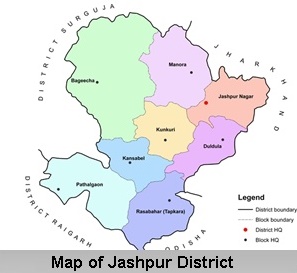 History of Jashpur District
History of Jashpur District
Jashpur District, situated in the central Indian state of Chhattisgarh, shares its borders with Jharkhand and Odisha. With its highly mountainous and forested terrain, Jashpur has a rich history and cultural heritage that dates back to the era of princely states and the British Raj. The district, which now houses the administrative headquarters in Jashpur Nagar, has an intriguing wealth in archaeology as well. Delving into the annals of time, it will be interesting to uncover the enigmatic past of Jashpur and its evolution into a significant district in present-day Chhattisgarh.
Formation of Jashpur into Princely State
Although historical accounts of Jashpur district reveal a certain level of ambiguity regarding its early history, some historical evidence suggests that the Dom dynasty ruled the region for a brief period. The last ruler of the Dom dynasty, Raibhan, met his defeat and demise at the hands of Sujan Rai, the founder of the Jashpur princely state in the colonial India. It is believed that Sujan Rai and his ancestors hailed from Banswada, a smaller state in the old Rajputana Province. They established their rule and kingdom in Sonpur.
According to folklore, Sujan Rai, the eldest son of Suryavanshi Raja, was on a hunting expedition when his father, the king, passed away. As per tradition and the urgent need for continuity, Sujan Rai`s younger brother was coronated as the king. However, upon Sujan Rai`s return from his expedition, he was offered the throne but chose to lead a reclusive life in the forest. His journey led him to Khudiya, the capital camp of the Dom kingdom, where he discovered an angered and dissatisfied population on the verge of rebellion under the rule of Raja Raibhan. Sujan Rai emerged as the leader of the popular uprising, defeating the Dom ruler in a decisive battle. Thus, Sujan Rai ascended to the throne, establishing the kingdom of Jashpur which later became a princely state. The present-day royal family of Jashpur traces its lineage back to this dynasty.
Jashpur under Bhosale rule
In earlier years, the ruler of Jashpur acknowledged the paramountcy of the Bhosale dynasty of Nagpur and continued to demonstrate honor and respect by wearing 21 Goras. However, during the reign of Mudhiji Bhonsle in 1818, Jashpur State was brought under the administration of Surguja State for more efficient governance. In 1950, Jashpur was included as a princely state within the Chhotanagpur States, which fell under the jurisdiction of the Government of Bengal. This arrangement endured until 1947-48.
Archaeological Wealth in Jashpur district
The Jashpur region is known for its archaeological wealth, which provides insights into its ancient past. Unfortunately, apart from the recent history of the https://www.indianetzone.com/59/princely_states_india, limited concrete facts or figures are available. Two literary works, "The Chhattisgarh Feudatory States Gazetteer" by E.M.D. Brett and "Jharkhand Jhankar" by Raghuvir Prasad, shed some light on the history of Jashpur. However, no other substantial sources have been discovered to date. The region is scattered with remnants of idols, statues, and ancient places of worship, albeit in a dilapidated state. Regrettably there is absence of carvings, scripts, or paintings.
Khudia Rani and Gondwana Mahadev are the two main archaeological sites in Jashpur exemplifying the development of civilization in the region. From the lesser known sources it has been deduced that sculpture was a well developed art in Jashpur.
Jashpur under British rule
Jashpur played a significant role during the British period. The town of Jashpur served as the capital of Jashpur State, which was one of the princely states under the Eastern States Agency. The ruling dynasty of Jashpur belonged to the Rajput Chauhan lineage. Following India`s independence in 1947, Jashpur State merged with the princely states of Raigarh, Sakti, Sarangarh, and Udaipur to form the Raigarh district.
Formation of Jashpur disctrict
From 1948 to October 10, 1956, Jashpur became part of the Chotanagpur Commission. When Madhya Pradesh was established as a new state of India on November 1, 1956, Jashpur became one of its integral parts. The region remained a part of Raigad district until May 25, 1998. Eventually, the area underwent reorganization, leading to the formation of 16 new districts in Madhya Pradesh, including Jashpur. However, due to judicial complications, the declaration could not be executed at that time. Subsequently, the Chief Minister of Madhya Pradesh, Shri Digvijaya Singh, responded to the aspirations of the people and officially announced the creation of Jashpur district on May 22, 1998. However, with the formation of the state of Chhattisgarh on November 1, 2000, Jashpur emerged as a separate district in the state.
Present-Day Jashpur district
Jashpur District, with its abundant natural resources and diverse tribal communities, has become a significant part of Chhattisgarh`s cultural and economic landscape. The district is known for its picturesque valleys, dense forests, and scenic waterfalls that attract tourists and nature enthusiasts. The region is predominantly inhabited by tribal communities such as the Oraon, Majhwar, and Munda tribes, each with their unique cultural practices and traditions.






